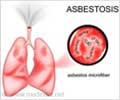The persistent risk caused by exposure to asbestos has prompted the Canadian Cancer Society to call for a ban on asbestos
The persistent risk caused by exposure to asbestos has prompted the Canadian Cancer Society to call for a ban on asbestos. The society has rejected long-held federal policy on asbestos and asked it to stop the export of the fire-retarding mineral still being mined at Quebec.
"The society believes that exposure to asbestos must stop so that asbestos-related diseases can be eliminated," Barbara Whylie, CEO of the Canadian Cancer Society, said.The society believes a comprehensive strategy is needed to address the health consequences of a substance that is said to kill thousands of people in Canada and around the world.
Although asbestos is internationally recognized as one of the worst cancer-causing materials ever to have been in widespread use, the society's decision was controversial because it undermines Ottawa's long-standing contention asbestos can be used safely and should be promoted.
Exposure to asbestos has been linked to an increased risk of lung cancer, mesothelioma, asbestosis, laryngeal cancer, cancers of the gastrointestinal tract and other diseases.
It is believed asbestos fibers attract cancer-causing agents after they enter the lungs. In many cases, the latency period can be 20 to 30 years after exposure.
The World Health Organization says that about 125 million people are exposed to asbestos at work and that at least 90,000 die annually from asbestos-related diseases. In Canada, almost one-third of the 1,097 workplace deaths in 2005 were attributed to asbestos, said the Canadian Centre for Occupational Health and Safety.
Advertisement
But 95 per cent of Canada's production, from several mines in Quebec, is exported, virtually all of it to developing countries, where it is used to make cheap building materials. Asian countries such as India, Indonesia and Thailand, are the major export markets for Canadian asbestos.
Advertisement
Although many countries have banned asbestos, Canada continues to allow it in children's toys and building materials, among other products.
Asbestos defenders criticized the society's move, arguing that the product is safe when properly used. They also say no distinction is made between the impact of chrysotile and more deadly forms of asbestos - crecodolite and amosite - which have already been banned.
Health Canada says asbestos is safe as long as it's in a "controlled use." That means it should be encapsulated in concrete or other materials that prevent the fibers from becoming airborne and inhaled.
The Canadian Cancer Society wants Ottawa to adopt a comprehensive strategy on asbestos that would: - Inform workers of the dangers of working and removing asbestos. - Develop a national surveillance system to track related diseases. - Maintain a public registry of asbestos-laden buildings. - Help communities reduce their asbestos mining exposure. - Inform importing countries of the health and environmental risks.
The cancer society will also recommend that the federal government stop trying to block efforts by the Rotterdam Convention, an UN-organized body, at its meeting in 2008, to place the variety of asbestos mined in Canada on the list of the world's most dangerous substances.
Source-Medindia
BIN/M










